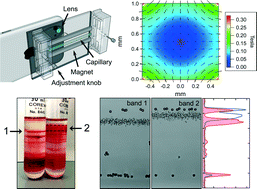Detection and quantification of subtle changes in red blood cell density using a cell phone†
Abstract
Magnetic levitation has emerged as a technique that offers the ability to differentiate between cells with different densities. We have developed a magnetic levitation system for this purpose that distinguishes not only different cell types but also density differences in cells of the same type. This small-scale system suspends cells in a paramagnetic medium in a capillary placed between two rare earth magnets, and cells levitate to an equilibrium position determined solely by their density. Uniform reference beads of known density are used in conjunction with the cells as a means to quantify their levitation positions. In one implementation images of the levitating cells are acquired with a microscope, but here we also introduce a cell phone-based device that integrates the magnets, capillary, and a lens into a compact and portable unit that acquires images with the phone's camera. To demonstrate the effectiveness of magnetic levitation in cell density analysis we carried out levitation experiments using red blood cells with artificially altered densities, and also levitated those from donors. We observed that we can distinguish red blood cells of an anemic donor from those that are healthy. Since a plethora of disease states are characterized by changes in cell density magnetic cell levitation promises to be an effective tool in identifying and analyzing pathologic states. Furthermore, the low cost, portability, and ease of use of the cell phone-based system may potentially lead to its deployment in low-resource environments.


 Please wait while we load your content...
Please wait while we load your content...